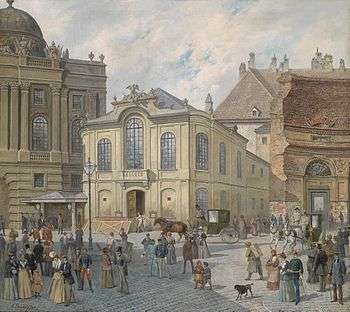Davide penitente
Davide penitente, K. 469 (also Davidde penitente), is a cantata by Wolfgang Amadeus Mozart, to texts by Saverio Mattei. The cantata was commissioned by the Wiener Tonkünstler-Societät, and first performed on 13 March 1785 in the Vienna Burgtheater. Most of the music is derived from the unfinished Great Mass in C minor, K. 427 (1782–83), although two arias ("A te, fra tanti affanni" and "Fra l'oscure ombre funeste") and a cadenza for the last movement ("Chi in Dio sol spera") were newly composed for the work.[1]
| Davide penitente | |
|---|---|
| Cantata by W. A. Mozart | |
 Burgtheater in Vienna, where the cantata was premiered on a commission by the Tonkünstler-Societät | |
| Catalogue | K. 469 |
| Related | Great Mass in C minor |
| Text | Saverio Mattei |
| Language | Italian |
| Based on | Psalms, First Book of Samuel |
| Composed | 13 March 1785: Vienna |
| Vocal | SATB chorus; soprano I and II, tenor soloists |
| Instrumental | orchestra |
It has a duration of approximately 45 minutes.
Authorship of text
The theme of the work is based on the Psalms and the First Book of Samuel of the Old Testament. The text was previously attributed to Lorenzo Da Ponte, following a report by Vincent Novello.[2] However, it is now known that the text is taken from Italian translations of the Psalms by Saverio Mattei (1742–95).[3]
Structure
- Alzai le flebili voci al Signor (Andante moderato: Chorus)
- Cantiamo le glorie e le lodi (Allegro vivace: Chorus)
- Aria: Lungi le cure ingrate (Allegro aperto: Soprano II)
- Sii pur sempre benigno (Adagio: Chorus)
- Duet: Sorgi, o Signore, e spargi i tuoi nemici (Allegro moderato: Sopranos I and II)
- Aria: A te, fra tanti affanni – Udisti i voti miei (Andante – Allegro: Tenor)
- Se vuoi, puniscimi (Largo: Double choir)
- Aria: Fra l'oscure ombre funeste – Alme belle (Andante – Allegro: Soprano)
- Terzetto: Tutte le mie speranze (Allegro: Sopranos I and II, Tenor)
- Chi in Dio sol spera (Adagio: Chorus) – Di tal pericoli non ho timor (Chorus)
References
- Michael Quinn, "Cantata," The Cambridge Mozart Encyclopedia, ed. Cliff Eisen and Simon P. Keefe (Cambridge: Cambridge University Press, 2006), 59–60.
- Geistliche Gesangwerke in Neue Mozart Ausgabe (1987), vol. I/IV/iii, p. XIV
- Saverio Mattei, I Libri Poetici Della Bibbia, 5 vols, Naples: Simoniana, 1766–1774.
External links
- Davide penitente: Score and critical report (in German) in the Neue Mozart-Ausgabe
- Sample of the text in the original Mattei print
- Text zur Passions-Musik "Ein Lämmlein geht und trägt die Schuld etc." von C. H. Graun, und zur Cantate "Davidde penitente" (Der büßende David) von W. A. Mozart. Berlin: Hayn, 1840.
- Davidde Penitente, K. 469: Scores at the International Music Score Library Project (IMSLP)